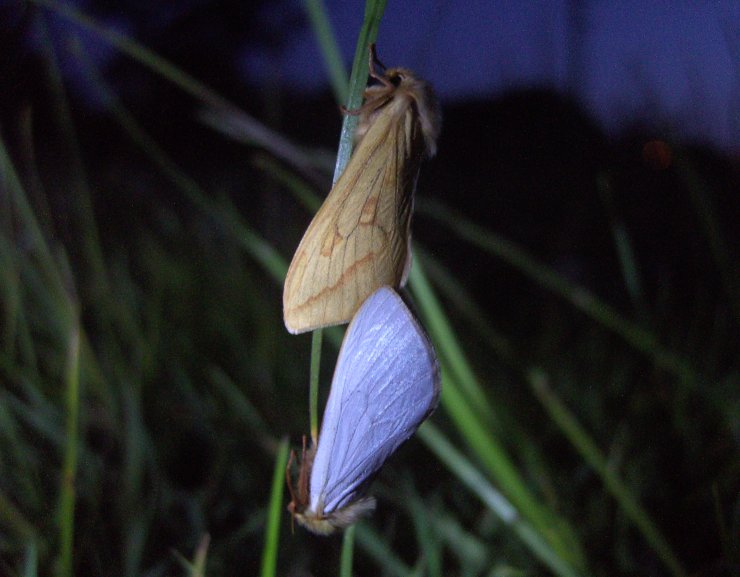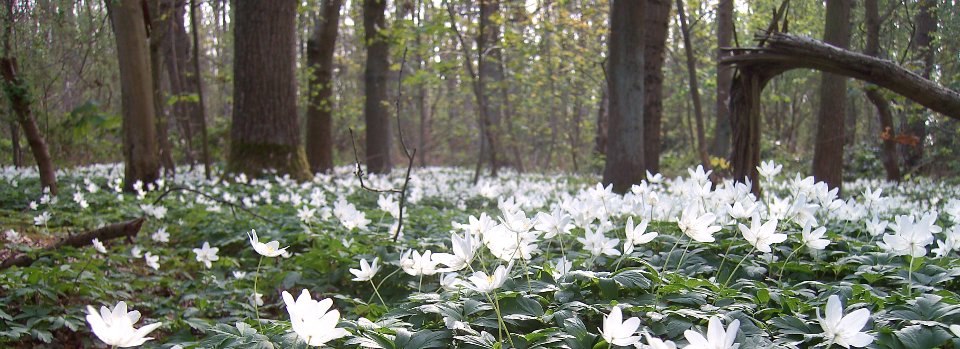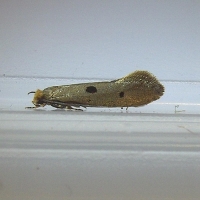Last night I finally managed to capture the image that I've been trying to get for the last few weeks. Ever since ghost moths were first discovered on the field adjacent to Lion Coppice I've been trying to get a photo of a mating pair of these beautiful moths. It was a chance encounter with a mating pair that first led me to identify the ghostly white moths that were visible at dusk hovering low over the grass near the coppice as being Hepialus humuli, more commonly known as the Ghost Moth or Ghost Swift. I was out looking for bat roosts and on that first encounter I had foolishly left my camera at home thinking it unlikely that I would see anything that could be photographed in near darkness.
Revisiting the area on successive nights I was able to take many pictures of the ghost moths in flight. The tendency of the males to hover more or less in the same place makes them relatively easy to photograph with a flash although my camera has a double-flash designed to reduce "red-eye" and the moths, being very photo-sensitive, would usually change course and move rapidly in some unexpected direction, often out of frame, in the time between the first flash and the second. I have an depressingly large collection of night-time flash photographs of nothing but grass!
But with a little luck and a lot of persistence I was able to get quite a number of reasonable shots of ghost moths in flight. Certainly they were clear enough for the County Moth Recorder, Tony Jacques, to be able to confirm my identification, but they weren't anything to write home about. Part of the difficulty, I discovered, is that the male ghost moth wings are so highly reflective that my rather simple little compact automatic camera was unable to get the exposure right. I suppose it must calculate the exposure from the average illumination across the whole scene, so a generally dark scene with a single, small, brilliant white object in it would inevitably result in the object being over-exposed. Without being able to manually override the exposure I was struggling to convince the camera to under-expose the image generally so that the moth itself would be correctly exposed.
The other issue I had was getting the camera to focus on such a small and agile object as a flying moth. This at least was a problem I knew how to solve. By pointing the camera at the ground at the approximate distance that I wanted to photograph the moth, then squeezing and holding the shutter without triggering it, I could get the auto-focus to lock at that distance. Then it was a matter of pointing the camera in the general direction of the moth, wait for it to come within the range I had focussed the camera for, then a final squeeze to take the shot. With practice and luck I came away with quite a few correctly focussed, if over-exposed, images, the best of which can be seen in the ghost moths gallery.
But I still wanted to get a good shot of a pair of ghost moths mating. The trouble was that since that first chance discovery I hadn't come across a single mating pair. I suppose they mostly disappear into the undergrowth or the tree canopy and are quickly out of sight, so I knew it would be down to sheer luck if I was going to be able to find and this time photograph another pair. But after going out at dusk on most evenings for the past two or three weeks I was beginning to wonder if I would get another chance before the end of the ghost moth mating season. Then last night it all came together. I found a flying female, watched it as it flew across my path to encounter a male. The two joined almost immediately and settled on a blade of grass where they remained completely still.
Seizing my opportunity I got down on the ground and gently moved the camera into position. Conditions were perfect; not even the slightest breeze so the pair were completely stationary in front of the camera making it possible to have a long exposure without blurring. I tried a flash shot but as expected the moths were over-exposed and the shot was completely useless. So instead I disabled the flash and experimented with illuminating the moths with a pocket torch angled to one side. It was difficult to see whether the shots were coming out well in the darkness so I just kept snapping away whilst varying the angle of illumination and wrestling to persuade the auto-focus that I wanted to take a picture of the moth and not the grass behind.
I would have kept taking pictures for many more minutes, but a gentle breeze picked up and caused the moths, suspended on a single, narrow blade of grass, to sway ever so slightly, but enough to spoil photographs taken entirely by torchlight. It turns out that this shot required half a second of exposure so the entire scene and the camera had to be utterly motionless for that period of time; no mean feat without a tripod!
It wasn't until I returned home and downloaded the images onto my laptop that I was able to see if I had been successful. Out of all the shots I took this was the only one that was in focus, free of motion blur and well-illuminated. But that's okay; I was only really after the one shot. And now that I have it I am content to leave the ghost moths in peace once more. Let's hope that the developers will leave them in peace too.
For those who care, the image was taken with a Vivitar Vivicam X30 camera. 1/2 second at f/2.8. Illuminated by white light LED torch and a little moonlight. The image was cropped for this website but was not otherwise altered.


